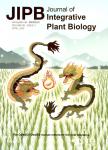Constructing a high-density linkage map for Gossypium hirsutum × Gossypium barbadense and identifying QTLs for lint percentage
Constructing a high-density linkage map for Gossypium hirsutum × Gossypium barbadense and identifying QTLs for lint percentage作者机构:State Key Laboratory of Cotton BiologyKey Laboratory of Biological and Genetic Breeding of Cottonthe Ministry of AgricultureInstitute of Cotton Researchthe Chinese Academy of Agricultural Sciences Agricultural College of Jiangxi Agricultural University Academy of Agricultural Sciences of Luohe City of Henan Province College of Bioscience and BiotechnologyHunan Agricultural University College of AgronomyHunan Agricultural University Agricultural College of Southwest University
出 版 物:《Journal of Integrative Plant Biology》 (植物学报(英文版))
年 卷 期:2015年第57卷第5期
页 面:450-467页
核心收录:
基 金:funded by the National Basic Research Program of China (973 Project) (2010CB126000) the National High Technology Research and Development Program of China (2012AA101108) the National Natural Science Foundation of China (31101188) the fund project of Director (SJA1203)
主 题:Cotton (Gossypium spp.) genetic linkage map Gossypiumbarbadense lint percentage simple sequence repeat
摘 要:To introgress the good fiber quality and yield from Gossypium barbadense into a commercial Upland cotton variety, a high‐density simple sequence repeat (SSR) genetic linkage map was developed from a BC1F1 population of Gossypium hirsutum × Gossypium barbadense. The map com-prised 2,292 loci and covered 5115.16 centiMorgan (cM) of the cotton AD genome, with an average marker interval of 2.23 cM. Of the marker order for 1,577 common loci on this new map, 90.36% agrees well with the marker order on the D genome sequence genetic map. Compared with five pub-lished high‐density SSR genetic maps, 53.14% of marker loci were newly discovered in this map. Twenty‐six quantitative trait loci (QTLs) for lint percentage (LP) were identified on nine chromosomes. Nine stable or common QTLs could be used for marker‐assisted selection. Fifty percent of the QTLs were from G. barbadense and increased LP by 1.07%–2.41%. These results indicated that the map could be used for screening chromosome substitution segments from G. barbadense in the Upland cotton background, identifying QTLs or genes from G. barbadense, and further developing the gene pyramiding effect for improving fiber yield and quality.



